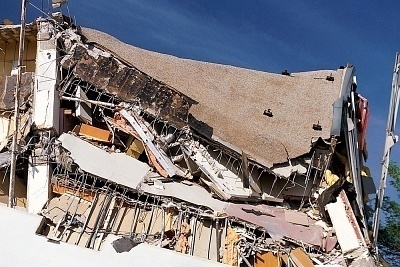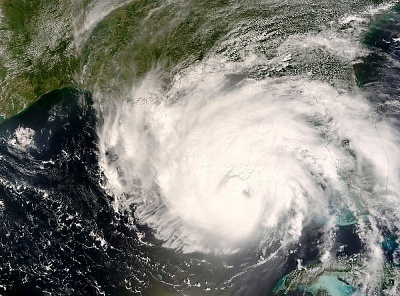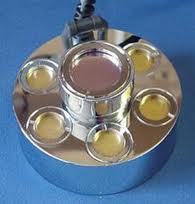An earthquake is caused when two blocks or plates of the Earth slip past each other in the lateral, vertical, or a combination of directions in a sudden manner. Due to the large pressures that develop between the Earth’s plates along fault lines at the Earth’s surface, one of the bodies will eventually give way. This resulting movement results in one of the plates moving above or to the side of the other during the resulting earthquake. A common question that arises amongst students and the general public is what causes earthquakes.
Common Earthquake Terms
The location on the earth’s surface at the center of the quake is referred to as the epicenter with the exact position of the start of the movement underground is the hypocenter. In some areas of the world, an earthquake will have a foreshock which is a smaller earthquake occurring in the same location as a larger quake that follows in time. Current technology does not allow scientists to predict if an earthquake is really a foreshock or not until a larger quake actually occurs.
The main earthquake is referred to as the mainshock. A mainshock quake will always have one or many aftershocks which are smaller earthquakes occurring after the main event. Based on the size of the mainshock, aftershocks can be experienced for a number of days, months, or even more than a year after the primary earthquake.
What Causes Earthquakes?
Of the four layers of the Earth: the crust, mantle, inner core, and outer core; the top of the mantle and the crust make up the thin outer skin of the planet. This “skin” is comprised of a number of pieces that continue to slowly move around and bump into each other. These pieces are called tectonic plates with the edges of the plates being referred to as plate boundaries. Along the boundary lines are tectonic faults which are the location of most of the world’s earthquakes. When the plates move far enough, the edges of them will unstick or separate along one of the fault lines and result in an earthquake occurring.
Why Does the Earth’s Surface Move During an Earthquake?

During tectonic plate movement, the edges of the plates remain stuck together at the fault lines. This results in a significant amount of energy being stored. As this force overcomes the friction at the edges of the fault-line and the plate(s) unstick, the energy is released. At this point, the energy moves outward or radiates from the fault in 360 degrees (or all directions). These are referred to as seismic waves. The seismic waves then shake the Earth’s surface as they move through it. As the waves reach the surface, the ground and any structures on it are shaken or moved. The move severe the earthquake, the more the ground and structures will shake or move.
What is Elastic Rebound?
The Elastic rebound theory was originally presented by Henry Reid who studied the earthquake of 1906. His theory suggested that over time, rocks bent and twisted to the point that they reached a breaking point. At this point, there was a sudden snap that would force the plates to separate. After this, the plates would have to move back into place and would cause the shaking felt in an earthquake. The snap and resulting rebound are referred to as an “elastic rebound.” Since the time of Henry Reid’s theory, it has been proven to be true using modern equipment and GPS to measure the twisting and movement of the Earth’s tectonic plates.
How Are Earthquakes Measured?
A seismograph is a scientific machine used to record an earthquake. The machines create a recording called a seismogram which depicts the strength of an earthquake. The seismograph consists of a base set into the ground and has a heavy weight that hangs free. When the ground is shaken by an earthquake, the base of the machine will move, but spring holding the hanging weight will absorb the movement. The recording is made of the difference of the position of the shaking and motionless parts of the device.
Since the size of an earthquake is based on the size and amount of slip incurred on the fault, it is not something that can be measured due to the distance beneath the earth’s surface of the slippage occurring. The seismogram recordings are able to measure the strength of the quake based on ground movement with the length of the line wiggle on the printout being a representation of the amount of slippage occurring during the earthquake. The final size of the quake is called the magnitude and is measured on the Moment magnitude scale which replaced the legacy Richter scale.
How Does the Richter Scale Work?
The Richter Magnitude scale was developed in the 1930s and is used to assign a number to express the amount of energy contained in an earthquake. The magnitude is based on a base-10 logarithmic scale that is determined by using the logarithm of the amplitude of waves measured by a seismograph. An earthquake measuring 5.0 on the Richter scale has an energy release approximately 31.6 times more than one measured as a 4.0 on the same scale. The scale has since been replaced by the moment magnitude scale (MMS) during the 1970s but still finds use in Russia and neighboring countries.
What is the Moment Magnitude Scale?
The moment magnitude scale (MMS or MW) is the standard in use by seismologists to measure the size of earthquakes as a function of the total energy released. The total magnitude is based on the seismic moment of the earthquake. This is equal to the rigidity of the Earth multiplied by the average amount of slip on the fault and total size of the area which slipped. The newer scale includes magnitude values that are similar to the Richter scale and is used by the U.S. Geological Survey.
How Is the Location of an Earthquake Determined?
Another use of a seismogram is to locate an earthquake by being able to see both the P and S waves created by the quake. Since P waves move faster than S waves, they can be used to determine where an earthquake occurred. The further from an epicenter of an earthquake a seismogram is located, the greater the distance there will be between the faster moving P waves and the following S waves. As a result, by analyzing the difference in time between the two wave types on a seismogram, a scientist can tell how far the earthquake was from that position. Since seismographs do not detect direction, a location is determined by using three or more seismograms taken from the same time to triangulate the epicenter of an earthquake.
Can Earthquakes Be Predicted?
Modern technology is not able to predict the likelihood of an earthquake occurring. Current predictions are that this ability will be unlikely to occur in the near future other than knowing that on any fault line there will eventually be another earthquake to occur in the future. Although there are a number of anecdotal stories about certain people or animals being able to predict an earthquake, there is no scientific evidence to confirm or deny this ability.
Earthquake Safety
As with any natural disaster, it is never too early to make preparations for an earthquake if one lives in an area known to experience quakes. The following are seven basic tips recommended by the U.S. government for earthquake safety:
Tip #1 – Secure Potential Hazards Now
Taking time to eliminate potential safety hazards during the course of the normal work day or week can save money and lives during an actual earthquake. These include unsecure items that can become airborne during the severe shaking that occurs during an earthquake such as unstrapped water heaters, bookcases, computers not set in brackets, and furniture such as bookshelves or large units.
Tip #2 – Make an Earthquake Plan
Many families take this a step further and expand their emergency preparedness plan to include all major contingencies. The plan should include a reunion plan in the event disaster strikes while the family is scattered amongst school, work, and the home. It should also include a common, out-of-state contact phone number and name for the family to use to gain contact with each other, location of emergency supplies, and other important information for recovering from the tragedy. Taking the time to plan today will save angst, time and speed a return to normalcy in the future.
Tip #3 Create a Disaster Kit
The events of the past decade have taught that everyone needs to have disaster kit supplies store in readily accessible locations at work, home, and in the family vehicles. Having an emergency kit at-hand can help families reduce the total impact of an earthquake or other natural disaster. Some of the common supplies recommended to include in disaster kits include water, flashlights, food, batteries, portable radios, first aid kits, extra medications, cash, a fire extinguisher, and a whistle.
Tip #4 Ensuring the Safety of Your Home
Most homes are not close to the level of safety required during a natural disaster. Whether or not you are renting or own your home or apartment, there are steps that can be taken to improve the overall safety. These include checking the foundation, bracing walls on the verge of crippling, locating and fixing vulnerable piping and unreinforced masonry. Normally a contractor will need to be retained to identify the building weaknesses before obligating monies to fix the issues.
Tip #5 Taking the Appropriate Action During an Earthquake
Learning and teaching your family what to do during an earthquake can help your loved ones avoid injury. When an earthquake occurs, the U.S. government recommends individuals drop to the floor and then take cover under a sturdy object such as a desk or table and hold on to it firmly. Depending on the size of quake or damage being done to the building you are located, you will need to be prepared to move with the furniture until the shaking from the earthquake ceases.
Tip #6 Check Your Surroundings
Immediately after an earthquake occurs, be prepared to check the surrounding area for damage or injuries to personnel that require attention. Obtaining training in basic first aid and damage assessment techniques will help you be an added value to the first responders in the local area who will be overwhelmed immediately after disaster strikes. All damage to gas, water, electrical lines, and sewage should be reported to the local government response center (if established) as soon as practicable.
Tip #7 Establish Communications
After disaster strikes, establish communications is a critical step in a family’s recovery efforts. A portable radio will allow you to obtain the most current safety and informational advisories. If your home has suffered damage, establish contact with the insurance company as soon as you can to start the claims process. In an officially declared, national disaster, there will be additional resources made available to those suffering from the local, state, and federal governments.
What Should You Not Do After an Earthquake?
Just as important as what to do after an earthquake is what you should not do. The following tips are a starting point on actions to avoid taking:
Tip #1 – If the gas to your home or apartment is off or turned off, DO NOT turn it back on. The gas company should turn it on once the lines are confirmed safe again.
Tip #2 – Avoid using electrical equipment, appliances, matches, lighters, or camp stoves until you make sure there are no gas leaks. The uses of these devices can create a spark that can result in an explosion or fire.
Tip #3 – Avoid using the phone unless it is a fire or medical emergency. The phone lines will be required for emergency response. If you require immediate help and can’t get through on the phone, send a bystander to seek help for the situation.
Tip #4 – Don’t wait for the police, ambulance, or firefighters to show up to help. They may take hours to show up based on the number of emergencies reported in your local area (if they show at all).




Follow Us!